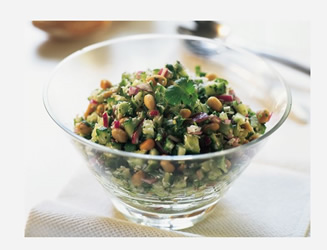Recently I saw someone looking through my desk, at the handouts/pamphlets I typically have around on the daily. This person asked me when I approached if I knew of foods which were less than 10% fat, by calorie content. It didn’t take me long to realize he was following the new Ornish program (named after the noted physician Dean Ornish). That was certainly a difficult task for me, coming up with foods that met this criteria. Yet, I had only been briefly aware of this diet’s existence prior to his arrival and question. After he left with some good ideas on foods that meet this, I started in on researching this program for myself. It wasn’t long before I realized why it’s taken off so much in the last several years.
This program centers around controlling how many calories you get per day from fats. If you maintain a diet low in fats, the calorie count itself will not be a problem. These do not include things like nuts, seed butters, or legumes as a result, as these are mostly filled with oils and fats. What about something as innocuous as popcorn? Well that has almost 20% of its calories from fat, believe it or not (120 calories and 20 from fats). It certainly can be a challenge to find foods that fit the criteria of the Ornish diet as a result.
The diet itself specifies eating foods such as whole grains, vegetables, soybean products, and legumes. The diet also puts no strict ceiling to how much of each you can eat, as long as they have less than 10% fat as part of their calorie content. This cuts out most meats, cuts out dairy (well egg whites are allowed) not including non-fat milks and yogurts. The Ornish diet also requires people to not eat foods with natural oils, even things like olive oil are not permitted. Fish can be eaten, if it’s not fatty, like salmon and mackerel, and flaxseed is a permitted oil for this program.
 One of the reasons the Ornish diet works is much the same as the reason the Paleo or “Caveman” diet works (or the Mediterranean diet for that matter). By removing unnatural and processed foods from our diet, we are able to avoid a lot of complex carbohydrates and fats that were not part of our evolutionary staple diet. Once they are removed, our body’s metabolism greatly increases, allowing us to more easily process the foods we eat, and also burn more fat. This has been known for a few years, perhaps even a decade or more, but these diets certainly can provide results that are positive given the overall goals underlying these food choices.
One of the reasons the Ornish diet works is much the same as the reason the Paleo or “Caveman” diet works (or the Mediterranean diet for that matter). By removing unnatural and processed foods from our diet, we are able to avoid a lot of complex carbohydrates and fats that were not part of our evolutionary staple diet. Once they are removed, our body’s metabolism greatly increases, allowing us to more easily process the foods we eat, and also burn more fat. This has been known for a few years, perhaps even a decade or more, but these diets certainly can provide results that are positive given the overall goals underlying these food choices.
What’s the Scientific Community Saying about the Ornish Diet
If you have the time, take a moment and visit Dean Ornish’s site. He does actually try to provide a bit of clinical research to support his claims. The primary study cited is a weak one, however, with few people and poor selection of candidates. However, it does show that the diet he recommends in fact worked in helping to prevent heart disease. There was not a group that was “high fat” intake, to compare the results. On account of this, the studies on the use of the Ornish diet are still ongoing and more research is needed on its specific guidance.
However, since this diet is similar to others like the Paleo diet, it’s clear that it may have the same benefits. The reduction in body fat is undeniable from the Paleo diet, so the Ornish diet should offer something similar. The real question is, is it worth the added expense and trouble to refine your food intake to such a small selection or stick with the wider Paleo diet’s choices? Typically the answer is go with what you know best, so if someone has done the “Caveman” diet in the past, they likely should stick with that one instead.
What’s worse about the Ornish diet, given its prescriptions about fats, is that it ignores the plethora of evidence that suggests carbohydrates are actually what the problem is. The obesity epidemic has been consistently linked to carbohydrates, particularly in processed foods, in our diets. This has been linked to diabetes, heart disease and other illnesses as well. With a 10% fat diet, many people in studies showed less significant LDL, but it was also more dense. This indicates there may be a higher risk of heart disease, not a reduced one. For this reason, the Ornish diet really needs to some good science to back it up, given this. Still, the program continues to grow in popularity, and perhaps real data will soon be available to assess its viability.